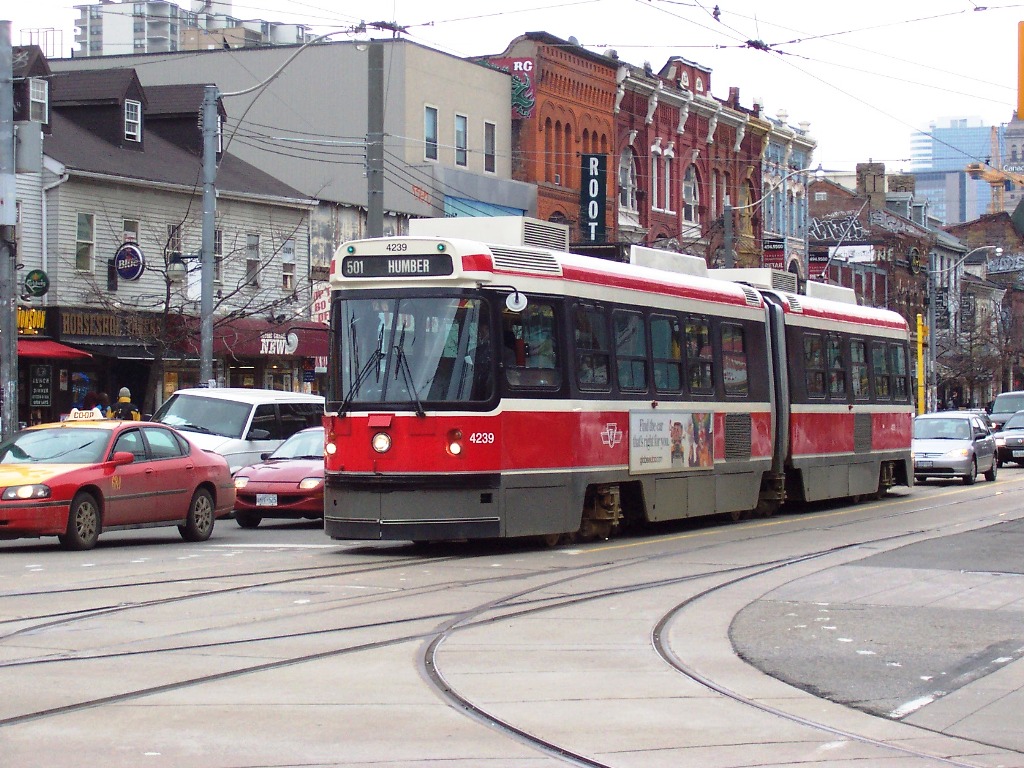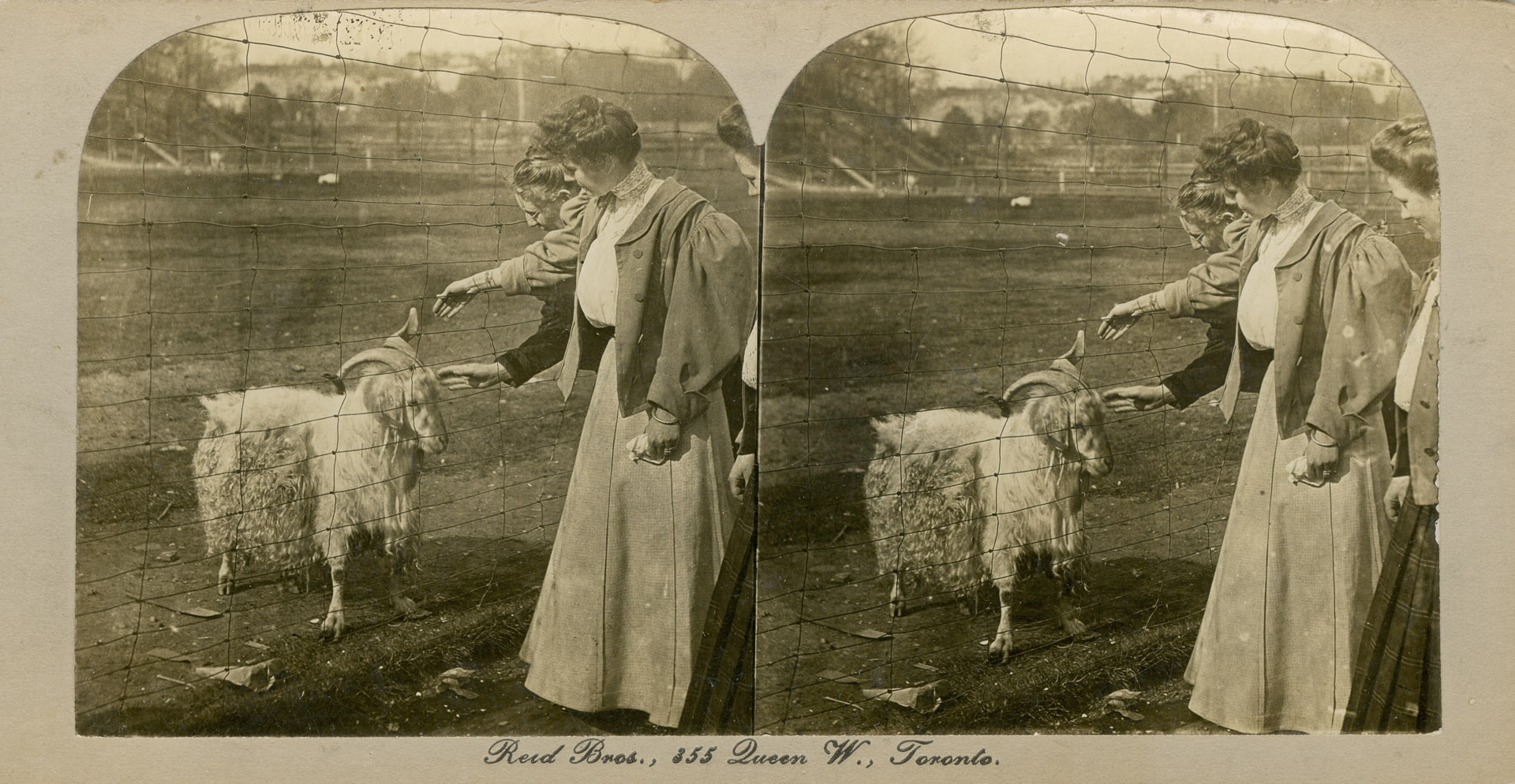|
S-series (Toronto Subway)
The S series was the rolling stock of light metro used on Line 3 Scarborough, part of the subway system of Toronto, Ontario, Canada. They were built from 1983 to 1986 for the Toronto Transit Commission (TTC) by the Urban Transportation Development Corporation (UTDC) in Millhaven, Ontario. The trains use UTDC's proprietary linear motor-based Intermediate Capacity Transit System (ICTS, now branded as Bombardier Innovia Metro) and are its Mark I model, which is also used by the Vancouver SkyTrain and the Detroit People Mover. They consist of 14 married pair sets (28 cars total) with fleet numbers 3000 to 3027, and are not compatible with the trains on other Toronto lines, which use conventional motors. Test runs took place in 1984 and full service began in 1985. When the line opened, 12 sets operated individually as two-car units. In 1986, two more sets were added, allowing sets to be coupled to form four-car units as ridership grew. All trains operated automatically without h ... [...More Info...] [...Related Items...] OR: [Wikipedia] [Google] [Baidu] |
Urban Transportation Development Corporation
The Urban Transportation Development Corporation Ltd. (UTDC) is a former State-owned enterprise, Crown corporation owned by the Government of Ontario, Canada. It was established in the 1970s as a way to enter what was then expected to be a burgeoning market in advanced light rail mass transit, mass transit systems. It developed significant expertise in linear propulsion, steerable trucks and driverless system controls which were integrated into a transit system known as the Bombardier Innovia Metro, Intermediate Capacity Transit System (ICTS). It was designed to provide service at rider levels between a traditional Rapid transit, subway on the upper end and buses and streetcars on the lower, filling a niche aimed at suburbs that were otherwise expensive to service. Urban Transportation Development Corporation Ltd. was a holding company. During its time it held several wholly owned subsidiary companies: * Metro Canada Ltd. was established as the contracting, delivery and operat ... [...More Info...] [...Related Items...] OR: [Wikipedia] [Google] [Baidu] |
Loyalist, Ontario
Loyalist is a lower-tier township municipality in central eastern Ontario, Canada on Lake Ontario. It is in Lennox and Addington County and consists of two parts: the mainland and Amherst Island. It was named for the United Empire Loyalists, who settled in the area after the American Revolution. Loyalist Township was formed on January 1, 1998, through the amalgamation of Amherst Island Township, Ernestown Township, and Bath Village. Communities The primary centres of settlement in Loyalist are Amherstview, Bath and Odessa. Smaller communities include Asselstine, Bayview, Emerald, Ernestown, Links Mills, McIntyre, Millhaven, Morven, Nicholsons Point, Stella, Storms Corners, Switzerville, Thorpe, Violet and Wilton. Since Loyalist Township is the only municipal level of government in the area, the boundaries of most ''mainland'' settlements are unofficial and matters of tradition. Amherstview Amherstview is named for Amherst Island, located directly to the south in Lake Ontar ... [...More Info...] [...Related Items...] OR: [Wikipedia] [Google] [Baidu] |
Toronto Zoo
The Toronto Zoo is a zoo located in Toronto, Ontario, Canada. Encompassing , the Toronto Zoo is the largest zoo in Canada averaging around 1.2 million visitors a year. The zoo is divided into seven zoogeographic regions: Indo-Malaya, Africa, Americas, Tundra Trek, Australasia, Eurasia, and the Canadian Domain. Some animals are displayed indoors in pavilions and outdoors in what would be their naturalistic environments, with viewing at many levels. The zoo also has areas such as the Kids Zoo, Waterside Theatre, and Splash Island. The zoo has one of the most taxonomically diverse collection of animals on display of any zoo worldwide and is currently home to over 3,000 animals (including invertebrates and fish) representing over 300 species. The zoo is open to the public every day of the year. The zoo is a corporation owned by the City of Toronto government. Founded by Hugh A. Crothers and business partner, John Cameron Egan, who became the first Chairman of the Metro Toronto Zool ... [...More Info...] [...Related Items...] OR: [Wikipedia] [Google] [Baidu] |
Halton County Radial Railway
The Halton County Radial Railway is a working List of transport museums, museum of electric tram, streetcars, other railway vehicles, buses and trolleybuses. It is operated by the Ontario Electric Railway Historical Association (OERHA). It is focused primarily on the history of the Toronto Transit Commission (TTC) and its predecessor, the Toronto Transportation Commission, Its collection includes PCC streetcar, PCC, Peter Witt streetcar, Peter Witt, Canadian Light Rail Vehicle, CLRV and ALRV, and earlier cars from the Toronto streetcar system as well as G series (Toronto subway), G-series and M series (Toronto subway), M-series Toronto subway cars. The museum is open to the public, with rides on many of its vehicles. It is located between the villages of Rockwood, Ontario, Rockwood and Campbellville, Ontario, Campbellville in Milton, Ontario, Milton, Ontario, Canada, along part of the Toronto Suburban Railway's former Right-of-way (transportation), right-of-way. The tracks conform ... [...More Info...] [...Related Items...] OR: [Wikipedia] [Google] [Baidu] |
G Series (Toronto Subway)
The G series was the first rolling stock of rapid transit cars used on the Toronto subway, built 1953–1959 by the Gloucester Railway Carriage and Wagon Company of Gloucester, England, for the Toronto Transit Commission (TTC) of Toronto, Canada. As the only Toronto subway cars to be manufactured outside of Canada, its design was mainly influenced by the Q38 and R stocks of the London Underground. Since the TTC's original concept for the subway system foresaw the use of rapid transit cars derived from the Presidents' Conference Committee (PCC) design of its streetcar network, the cars were also equipped with bulls-eye incandescent lighting similar to that of a PCC, and a small operator's cabin located in the front left corner of each car. To this end, it was influenced by the 6000-series cars used on the Chicago "L", felt through the work of DeLeuw, Cather & Co. of Chicago, whom the TTC contracted as a consultant for the rapid transit project. The G-series cars were frequ ... [...More Info...] [...Related Items...] OR: [Wikipedia] [Google] [Baidu] |
Livery
A livery is an identifying design, such as a uniform, ornament, symbol, or insignia that designates ownership or affiliation, often found on an individual or vehicle. Livery often includes elements of the heraldry relating to the individual or corporate body featured in the livery. Alternatively, some kind of a personal emblem or badge, or a distinctive colour, is featured. The word itself derives from the French language, French ''livrée'', meaning ''dispensed, handed over''. Most often it would indicate that the wearer of the livery was a servant, dependant, follower or friend of the owner of the livery, or, in the case of objects, that the object belonged to them. In the late medieval phenomenon of bastard feudalism, livery badges worn by the "retainers" of great lords, sometimes in effect private armies, became a great political concern in England. Etymology "In the ''Black Book'' of 1483, it was laid down that each person should receive '... for his Livery at night, h ... [...More Info...] [...Related Items...] OR: [Wikipedia] [Google] [Baidu] |
H Series (Toronto Subway)
The H series is the third series of rapid transit rolling stock used in the subway system of Toronto, Ontario, Canada. They were built in six production sets, named H-1 to H-6, from 1965 to 1990 in Thunder Bay, Ontario, for the Toronto Transit Commission (TTC). The entire rolling stock was retired in 2014, though thirteen remaining cars still exist as work cars, including three H-1 cars. The first five sets were manufactured by Hawker Siddeley Canada until 1979, when the company was purchased by the Urban Transportation Development Corporation (UTDC), which then took over production. They operated alongside their predecessor models, the M series, while the H-6 trains replaced the last remaining G-series trains in 1990. All H-series cars were manufactured in a facility Hawker Siddeley inherited from Canadian Car & Foundry, which had earlier produced PCC streetcars for the TTC's streetcar network. The facility was taken over by Bombardier Transportation in 1991, which has con ... [...More Info...] [...Related Items...] OR: [Wikipedia] [Google] [Baidu] |
One-person Operation
One-person operation (OPO), also known as driver-only operation (DOO), one-man operation (OMO), single person train operation (SPTO), or one-person train operation (OPTO), similarly to driver-controlled operation, is operation of a train, bus, or tram by the driver alone, without a conductor. On one-person operated passenger trains, the engineer must be able to see the whole train to make sure that all the doors are safe for departure. On curved platforms a CCTV system, mirror or station dispatch staff are required. Although extra infrastructure such as cameras and mirrors might require additional investment, one-person operation is usually faster and cheaper to implement than automatic train operation, requiring a smaller investment in, for example, platform intruder detection systems and track protection (fencing, bridge-caging, CCTV etc.). In some cases, one-person operation can be seen as an intermediate step towards automatic train operation. While European freight tra ... [...More Info...] [...Related Items...] OR: [Wikipedia] [Google] [Baidu] |
Driverless Vehicle
Vehicular automation is using technology to assist or replace the operator of a vehicle such as a car, truck, aircraft, rocket, military vehicle, or boat. Assisted vehicles are ''semi-autonomous'', whereas vehicles that can travel without a human operator are ''autonomous''. The degree of autonomy may be subject to various constraints such as conditions. Autonomy is enabled by advanced driver-assistance systems (ADAS) of varying capacity. Related technology includes advanced software, maps, vehicle changes, and outside vehicle support. Autonomy presents varying issues for road, air, and marine travel. Roads present the most significant complexity given the unpredictability of the driving environment, including diverse road designs, driving conditions, traffic, obstacles, and geographical/cultural differences. Autonomy implies that the vehicle is responsible for all perception, monitoring, and control functions. SAE autonomy levels The Society of Automotive Engineer ... [...More Info...] [...Related Items...] OR: [Wikipedia] [Google] [Baidu] |
Automatic Train Operation
Automatic train operation (ATO) is a method of operating trains automatically where the driver is not required or is required for supervision at most. Alternatively, ATO can be defined as a subsystem within the automatic train control, which performs any or all of functions like programmed stopping, speed adjusting, door operation, and similar otherwise assigned to the train operator. The degree of automation is indicated by the Grade of Automation (GoA), up to GoA4 in which the train is automatically controlled without any staff on board. On most systems for lower grades of automation up to GoA2, there is a driver present to mitigate risks associated with failures or emergencies. Driverless automation is primarily used on automated guideway transit systems where it is easier to ensure the safety due to isolated tracks. Fully automated trains for mainline railways are an area of research. The first driverless experiments in the history of train automation date back to 1920 ... [...More Info...] [...Related Items...] OR: [Wikipedia] [Google] [Baidu] |
Traction Motor
A traction motor is an electric motor used for propulsion of a vehicle, such as locomotives, electric vehicle, electric or hydrogen vehicles, or electric multiple unit trains. Traction (engineering), Traction motors are used in electrically powered railway vehicles (electric multiple units) and other electric vehicles including electric milk floats, trolleybuses, elevators, roller coasters, and conveyor systems, as well as vehicles with electrical transmission systems (Diesel locomotive#Transmission types, diesel–electric locomotives, electric hybrid vehicles), and battery electric vehicles. Traction motor companies The word ''traction'' from Latin, being the Agent (grammar), agent noun of ''trahere'' "to pull" in the sense of "drawn" was used for the naming of traction engines developed circa 1870. The first experimental electric traction motor tramway of 1875 was rapidly developed internationally for city use. In the 19th century traction motor passenger car companies ... [...More Info...] [...Related Items...] OR: [Wikipedia] [Google] [Baidu] |





